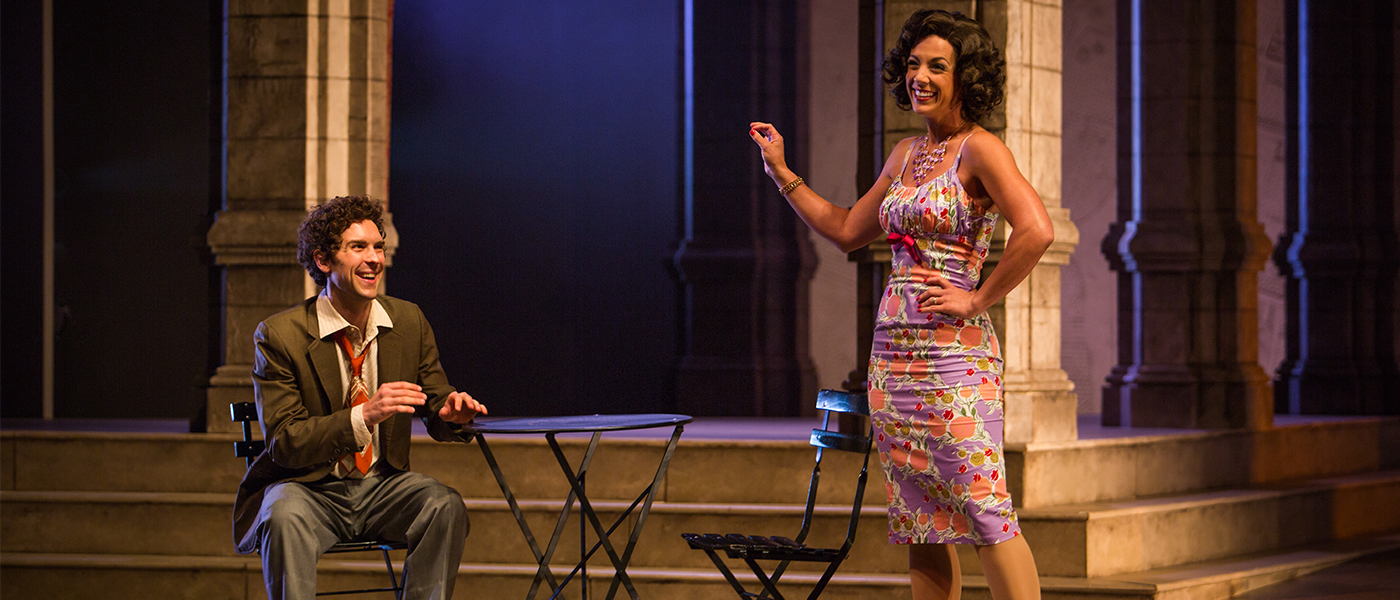Monastery by palazzo by piazza, Florence, Italy, packs in more sublime works of art than any other two square miles on earth. At Auburn’s Merry-Go-Round Playhouse, scenic designer David Arsenault’s gleaming marble-like set for The Light in the Piazza, dominated by a replica of Michelangelo’s David, flanked by white columns, reminds us of this.
Except for a moment in the second act when the action switches briefly to Rome, and he is covered by a map, we see David in every scene. We may know from the masterpiece what perfection is, but it is removed from us: We are not going see it in our lives.
Although the Adam Guettel-Craig Lucas musical qualifies as a Broadway hit, many audiences will be surprised where it takes them. Well-to-do Southern matron Margaret Johnson (Sally Wilfert) and her beautiful blond daughter Clara (Heather Botts) are tourists in summer 1953. Both wear white gloves, as if they wished to keep their distance from an alien, Catholic, garlic-eating culture. Awkward with even the easiest Italian phrases, they would be figures of fun, but here their first duet is the celebratory “Statues and Stories.”
Craig Lucas’ book, based on Elizabeth Spencer’s 1960 novella, is dilatory in giving us the reasons why mother and daughter are traveling. Director-choreographer Brett Smock is studiously coy in letting us see what the Johnsons would prefer to keep hidden. Clara is not merely girlish and coltish; inside her lovely body stands a child who is not going to grow up. We sense that American schools and playgrounds have been torment to her. We will also see events sympathetically through the eyes of an interfering mother, as in Gypsy.
Fate blows in quickly. A breeze blows off Clara’s hat and carries it across the piazza, where it is caught by an Italian man, Fabrizio Naccarelli (Nathan Gardner). The young people are instantly smitten. Attempting to head off inconvenient romance, Margaret steers her daughter toward the famed Uffizi Gallery, where Clara sings of her own deep yearnings, “The Beauty Is,” one of the show’s most affecting numbers. Before the act is over, the lovers are in a hotel room in the duet, “Say It Somehow.”
Composer Adam Guettel is an acquired taste, better approached in performance than recording. The grandson of legendary Richard Rodgers and son of Mary Rodgers (Once Upon a Mattress), Guettel claims influences as wide as Stevie Wonder and Igor Stravinsky, but especially British operatic composer Benjamin Britten. He will remind musical theater buffs of Stephen Sondheim and Jason Robert Brown. His music is infused with emotion, but it is never facile, even when the lovers come alive at first sight. Guettel’s score keeps The Light in the Piazza from becoming a “soap opera,” the words Leonard Maltin uses to dismiss the too-sweet 1962 movie version with Olivia de Havilland and Yvette Mimieux.
Like his grandfather, Guettel composes music to embody the dynamics of the whole, not just to ornament it. The 1950s might have been an “innocent” time, but our eyes are open now. Naccarelli’s sister-in-law Franca (Tracy Ganem) warns Clara in “The Joy You Feel” that she can’t trust any husband. We also learn of the pain in the Johnson marriage from Margaret’s solo, “Dividing Day.” Margaret’s unloving husband Roy (Don Meehan Jr.), a cigarette manufacturer, claims that a married Clara would lack the maturity to be a mother herself, even putting aside differences in language and culture.
Ah, but Craig Lucas’ book and Brett Smock’s direction never let us underestimate the allure of those Italians. Nathan Gardner’s Fabrizio is a compelling soloist (“Il Mondo era Vuoto” and “Passeggiata”) whose artistry does not shield us from his own maturity problems. Meanwhile, Fabrizio’s papa (Patrick Oliver Jones) embodies the masculine aestheticism missing in Margaret’s own mate, as in the duet, “Let’s Walk.”
The Light in the Piazza, in its first regional production, looks like producing artistic director Smock’s seasonal calling card. Together with music director Jeff Theiss, lighting designer Dan Ozminkowski and costumer Lucy Brown, Smock’s artistic vision lifts you up, resolving your doubts as Margaret does in her final solo, “Fable.”











